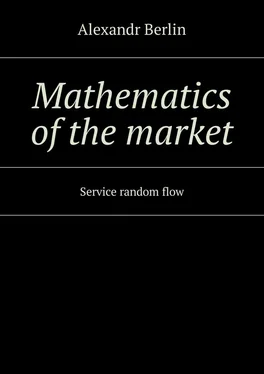Mathematics of the market
Service random flow
Alexandr Berlin
© Alexandr Berlin, 2017
ISBN 978-5-4485-9239-3
Created with Ridero smart publishing system
A (P relative). – relative consumption. The proposed load;
A loss(t 1, t 2) – the difference between the incoming supply of goods and serviced supplies of goods;
A inc. (t 1, t 2) – incoming supply of goods over a period of time (t 1, t 2);
A served. (t 1, t 2) – the sum of the quantities of goods handled by consumer group during the period (t 1, t 2).;
A TGD. – the demand value for time of greatest demand;
A obs. – the demand value during the observation;
a – the load intensity coming from a single source;
c‘ receivs the number of received requests;
c‘ serv – the number of serviced requests;
c‘ lost. – the number of lost requests;
c‘– average length of queue or average numbers delays batches of goods;
P max– maximum consumption;
P goods. – losses of volume of goods;
P request. – losses in the number of requests for suggestion of goods;
P goods. – losses of volume of goods;
P t- losses of implementation time;
p (γ> 0) the probability that the waiting time is greater than zero – that is, the probability of queue;
p (γ> t) – the probability of waiting for any incoming product over time t;
p (R> r) – the probability that the queue length exceeds the specified value r);
(γ) – the average waiting time in relation all requests received;
γ delay the average waiting time of only a delayed requests;
Λ (t 1, t 2) -the mathematical expectation of the number of supplies placed on the market in the time interval [t 1, t 2);
μ (t 1.t 2). – the instantaneous flow rate;
Chapter 1. What are the REELECTION CONSUMPTION. unit of measure of supply and demand
1.1. So what is the goods?
Let’s start with a quote of Keynes [ The General Theory of Employment, Interest, and Money by John Maynard Keynes.Book II: Definitions and Ideas]
“The perplexities which most impeded my progress in writing this book, so that I could not express myself conveniently until I had found some solution for them, are:
firstly, the choice of the units of quantity appropriate to the problems of the economic system as a whole;..
“That the units, in terms of which economists commonly work, are unsatisfactory can be illustrated by the concepts of the national dividend, the stock of real capital and the general price-level:”
“The community’s output of goods and services is a non-homogeneous complex which cannot be measured, strictly speaking, except in certain special cases, as for example when all the items of one output are included in the same proportions in another output.”
In order to take the definition of the unit of goods we use the obvious statement.
We define the goods the market, as something that you want to sell or that you want to buy. Let’s try to express this in numbers
Do you love cakes? I will sell them to you. You will buy and will want again. Finally, you can eat 10 cakes a day. And I offer you still. You say, “Enough!” I suggest to you free of charge 12 cakes a day, and you ungrateful say me “No!”. Moreover, buying cakes, you have some time to consume them, and not buy a new one
What is it? It is the overproduction!
I repeat the question: How much can you eat on the day cakes – 10, 12, 15? It doesn’t matter for math, but in principle there is some maximum quantity which you can consume in a certain period (a day, a month, a year).
Let’s try to find the indicator and we will call its – the relative consumption-
P relative. If the consumer is not in need of this product (saturation) P relative.=1,
If the consumer is just starting to purchases a goods
P relative. =0.
Therefore, the current state of the user can be reflected with help the value of the relative consumption
0 ≤ P relative.≤1
We will continue the search for the mathematical determination of relative consumption.
More details of this figure can be determined from the following reasoning.
Let’s introduce a unit of measure (denoted it a) “specific relative consumption”. It will the ratio of real consumption ( P relative) to the maximum possible (P max.)
P relative= P real/ P max= a
Then the maximum consumption in a given period will be equal to P max. We assume that no material (money, prices) and external factors (season, fashion) don’t limit you.
Next, let’s see how much you are consuming a really – P real.. By definition you can’t consume more than P max. (P real. < P max.).
If you considered a group of n consumers, applied the name – RELATIVE CONSUMPTION.
It will be
A= a n
1.2. Relative consumption
The relative consumption shows the possibility of participation of the consumer in the consumption (similar to a unit load in queuing theory). It indicates how many the goods the consumer is willing to buy. If a=1, the consumer in a given period will not buy a product, the other side it shows how satisfied requests of this user.
For example, from a website on the Internet, you can learn that the Scandinavians consume 8 liters of milk per week, and the Europeans 1 liter per week. One people physically can maximum consume 10 liters per week. Not analyzing for accuracy this information, we take these numbers as truth.
Then the relative consumption is equal for Scandinavians – 8/10, and for Europeans 1/10.
For sale of milk these numbers speak volumes.
1. The propensity for milk consumption in Scandinavia is close to saturation. As we showed research, selling products in a saturated market leads to big losses that are higher the closer the value of the relative consumption to the value 1. This means that the needs of this market are completely satisfied.
2. Judging the relative consumption for the sale of milk are higher Europe prospects because the market is not saturated.
However, it is necessary to make a reservation. Keynes divided the propensity to consume on two categories – objective and subjective factors. He wrote [ THE BOOK THIRD. THE PROPENSITY TO CONSUME. CHAPTER 8 ].
“In order to make our analysis clearer, it is advisable to divide these motives into two big groups: first of them we will include subjective and the second objective factors. Subjective factors, those describe psychological features of human character, and also those public habits and institutes, which though are not invariable, nevertheless hardly whether are subject to significant change over short time periods (excluding any coming out of the ordinary circumstances or revolutionary shocks)”.
In our example, the low level of relative consumption indicates the presence in the European behavior of the subjective factor, but at the same time indicates for the prospect of overcoming it (advertising, development of appropriate European tastes dairy products).
3. Relative consumption can be used to measure the level of poverty and wealth.
Saturation of the population with vital goods is usually calculated by the amount of consumption per person over a certain period (month, year). Relative consumption indicates the degree of saturation (ratio of maximum consumption to real consumption). This example cannot serve as such an indicator because it has a large share of subjective factors.
The low value of the relative consumption indicates poverty if this if this is happens due to the lack of material resources.
Читать дальше












